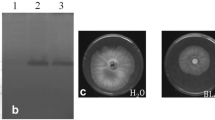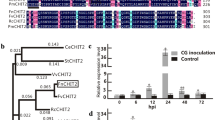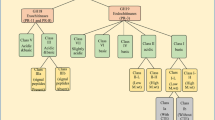Abstract
We have previously isolated a Brassica juncea cDNA encoding BjCHI1, a novel chitinase with two chitin-binding domains, and have shown that its mRNA is induced by wounding and methyl jasmonate treatment (K.-J. Zhao and M.-L. Chye, Plant Mol. Biol. 40 (1999) 1009–1018). By the presence of two chitin-binding domains, BjCHI1 resembles the precursor of UDA (Urtica dioica agglutinin) but, unlike UDA, BjCHI1 retains its chitinase catalytic domain after post-translational processing. Here, we indicate the role of BjCHI1 in plant defense by demonstrating its mRNA induction upon Aspergillus niger infection or caterpillar Pieris rapae (L.) feeding. To further investigate the biological properties of BjCHI1, we transformed tobacco with a construct expressing the BjCHI1 cDNA from the CaMV 35S promoter. Subsequently, we purified BjCHI1 from the resultant transgenic R0 plants using a regenerated chitin column followed by fast protein liquid chromatography (FPLC). Also, the significance of the second chitin-binding domain in BjCHI1 was investigated by raising transgenic tobacco plants expressing BjCHI2, a deletion derivative of BjCHI1 lacking one chitin-binding domain. Colorimetric chitinase assays at 25 °C, pH 5, showed no significant differences between the activities of BjCHI1 and BjCHI2, suggesting that chitinase activity, due to the catalytic domain, is not enhanced by the presence of a second chitin-binding domain. Both BjCHI1 and BjCHI2 show in vitro anti-fungal activity toward Trichoderma viride, causing reductions in hyphal diameter, hyphal branching and conidia size.
Similar content being viewed by others
References
Beintema, J.J. and Peumans, W.J. 1992. The primary structure of stinging nettle (Urtica dioica) agglutinin, A two-domain member of the hevein family. FEBS Lett. 299: 131–134.
Boller, T. 1985. Induction of hydrolases as a defense reaction against pathogens. In: J.L. Key and T. Kosuge (Eds) Cellular and Molecular Biology of Plant Stress, Alan R. Liss, New York, pp. 247–262.
Boller, T. 1992. Biochemical analysis of chitinase and ?-1,3-glucanases. In: S.J. Gurr, M.J. Mcpherson and D.J. Bowles (Eds) Molecular Plant Pathology: A Practical Approach, vol. II, IRL Press, Oxford, pp. 23–30.
Boller, T., Gehri, A., Mauch, F. and Vögeli, U. 1983. Chitinase in bean leaves: induction by ethylene, purification, properties, and possible function. Planta 157: 22–31.
Bradford, M.M. 1976. A rapid and sensitive method for the quantitation of microgram quantities of protein utilizing the principle of protein-dye binding. Anal. Biochem. 72: 248–254.
Broglie, K., Chet, I., Holliday, M., Cressman, R., Biddle, P., Knowlton, S., Mauvais, C.J. and Broglie, R. 1991. Transgenic plants with enhanced resistance to the fungal pathogen Rhizoctonia solani. Science 254: 1194–1197.
Broekaert, W.F., Van Parijs, J., Leyns, F., Joos, H. and Peumans, W.J. 1989. A chitin-binding lectin from stinging nettle rhizomes with antifungal properties. Science 245: 1100–1102.
Büchter, R., Strömberg, A., Schmelzer, E. and Kombrink, E. 1997. Primary structure and expression of acidic (class II) chitinase in potato. Plant Mol. Biol. 35: 749–761.
Chrispeels, M.J. and Raikhel, N.V. 1991. Lectin, lectin genes and their role in plant defense. Plant Cell 3: 1–9.
Collinge, D.B., Kragh, K.M., Mikkelsen, J.D., Nielsen, K.K., Rasmussen, U. and Vad, K. 1993. Plant chitinases. Plant J. 3: 31–40.
Dellaporta, S.L., Wood, J. and Hicks, J.B. 1983. A plant DNA minipreparation: version II. Plant Mol. Biol. Rep. 1: 19–21.
Does, M.P., Houterman, P.M., Dekker, H.L. and Cornelissen, B.J.C. 1999. Processing, targeting and antifungal activity of stinging nettle agglutinin in transgenic tobacco. Plant Physiol. 120: 421–431.
Fitchette-Laine, A.-C., Denmat, L.-A., Lerouge, P. and Faye, L. 1998. Analysis of N-and O-glycosylation of plant proteins. In: C. Cunningham and A.J.R. Porter (Eds) Methods in Biotechnology, vol. 3. Recombinant Proteins from Plants. Humana Press, Totowa, NJ, pp. 271–290.
Gooday, G.W. 1999. Aggressive and defensive roles for chitinases. In: P. Jollès and R.A.A. Muzzarelli (Eds) Chitin and Chitinases, Birkhäuser, Basel, Switzerland, pp. 157–170.
Grison, R., Grezes-Besset, B., Schneider, M., Lucante, N., Olsen, L., Leguay, J.-J. and Toppan, A. 1996. Field tolerance to fungal pathogens of Brassica napus constitutively expressing a chimeric chitinase gene. Nature Biotechnol. 14: 643–646.
Horsch, R.B., Fry, J.E., Hoffmann, N.L., Eichholz, D., Rogers, S.G. and Fraley, R.T. 1985. A simple and genetic method for transferring genes into plants. Science 227: 1227–1231.
Iseli, B., Boller, T. and Neuhaus, J.-M. 1993. The N-terminal cysteine-rich domain of tobacco class I chitinase is essential for chitin binding but not for catalytic or antifungal activity. Plant Physiol. 103: 221–226.
Kellmann, J.W., Kleinow, T., Engelhardt, K., Philipp, C., Wegener, D., Schell, J. and Schreier, P.H. 1996. Characterization of two class II chitinase genes from peanut and expression studies in transgenic tobacco plants. Plant Mol. Biol. 30: 351–358.
Kush, A., Goyvaerts, E., Chye, M.-L. and Chua, N.-H. 1990. Laticifer specific gene expression of Hevea brasiliensis (rubber tree). Proc. Natl. Acad. Sci. USA 87: 1787–1790.
Laemmli, U.K. 1970. Cleavage of structural proteins during the assembly of the head of bacteriophage T4. Nature 227: 680–685.
Lerner, D.R. and Raikhel, N.V. 1992. The gene for stinging nettle lectin (Urtica dioica agglutinin) encodes both a lectin and a chitinase. J. Biol. Chem. 267: 11085–11091.
Lin, W., Anuratha, C.S., Datta, K., Potrykus, I., Muthukrishnan, S. and Datta, S.K. 1995. Genetic engineering of rice for resistance to sheath blight. Bio/technology 13: 686–691.
Mauch, F., Mauch-Mani, B. and Boller, T. 1988. Antifungal hydrolases in pea tissue. Plant Physiol. 88: 936–942.
Mayer, R.T., Shapiro, J.P., Berdis, E., Hearn, C.J., McCollum, T.G., McDonald, R.E. and Doostdar, H. 1995. Citrus rootstock responses to herbivory by larvae of the sugarcane rootstock borer weevil (Diaprepes abbreviatus). Physiol. Plant. 94: 164–173.
Melchers, L.S., Apotheker-de Groot, M., van der Knaap, J.A., Ponstein, A.S., Sela-Buurlage, M.B, Bol, J.F., Cornelissen, B.J.C., van den Elzen, P.J.M. and Linthorst, H.J.M. 1994. A new class of tobacco chitinases homologous to bacterial exo-chitinases displays antifungal activity. Plant J. 5: 469–480.
Nagy, F., Kay, S.A. and Chua, N.H. 1988. Analysis of gene expression in transgenic plants. In: S.B. Gelvin and R.A. Schilperoort (Eds) Plant Molecular Biology Manual, Kluwer Academic Publishers, Dordrecht, Netherlands, pp. B4: 1-29.
Neuhaus, J.M. Fritig, B., Linthorst, H.J.M., Meins, F., Mikkelsen, J.D. and Ryals, J. 1996. A revised nomenclature for chitinase genes. Plant Mol. Biol. Rep. 14: 102–104.
Neuhaus, J.M., Sticher, L., Meins, F. and Boller, T. 1991. A short C-terminal sequence is necessary and sufficient for the targeting of chitinase to the plant vacuole. Proc. Natl. Acad. Sci. USA 88: 10362–10366.
Peumans, W.J. and Van Damme, E.J.M. 1995. Lectins as plant defense proteins. Plant Physiol. 109: 347–352.
Rasmussen, U., Bojsen, K. and Collinge, D.B. 1992. Cloning and characterization of a pathogen-induced chitinase in Brassica napus. Plant Mol. Biol. 20: 277–287.
Roberts, W.K. and Selitrennikoff, C.P. 1988. Plant and bacterial chitinases differ in antifungal activity. J. Gen. Microbiol. 134: 169–176.
Saharan, G.S. 1993. Disease resistance. In: K.S. Labana, S.S. Banga and S.K. Banga (Eds) Breeding Oilseed Brassicas, Springer-Verlag, Berlin, pp. 181–205.
Sambrook, J., Fritsch, E. F. and Maniatis, T. 1989. Molecular Cloning: a Laboratory Manual, 2nd ed. Cold Spring Harbor Laboratory Press, Plainview, NY.
Schlumbaum, A., Mauch, F., Vögeli, U. and Boller, T. 1986. Plant chitinases are potent inhibitors of fungal growth. Nature 324: 365–367.
Soedjanaatmadja, U.M.S., Subroto, T. and Beintema, J.J. 1995. Processed products of the hevein precursor in the latex of the rubber tree (Hevea brasiliensis). FEBS Lett. 363: 211–213.
Sticher, L., Hofsteenge, J., Neuhaus, J.-M., Boller, T. and Meins, F. Jr. 1993. Posttranslational processing of a new class of hydroxyproline-containing proteins. Plant Physiol. 101: 1239–1247.
Thomas K.R., Davis, B. and Mills, J. 1979. The effect of betaglucuronidase and chitinase on the cell wall of Aspergillus niger and Aspergillus fumigatus. Microbios 25: 111–123.
Thomma, B.P.H.J., Eggermont, K., Penninckx, I.A.M.A., Mauch-Mani, B., Vogelsang, R., Cammue, B.P.A. and Broekaert, W.F. 1998. Separate jasmonate-dependent and salicylate-dependent defense-response pathways in Arabidopsis are essential for resistance to distinct microbial pathogens. Proc. Natl. Acad. Sci. USA 95: 15107–15111.
Van Parijs, J., Broekaert, W. F., Goldstein, I. J. and Peumans W. J. 1991. Hevein: an antifungal protein from rubber-tree (Hevea brasiliensis) latex. Planta 183: 258–264.
Vijayan, P., Shockey, J., Levesque, C.A., Cook, R.J. and Browse, J. 1998. A role for jasmonate in pathogen defense of Arabidopsis. Proc. Natl. Acad. Sci. 95: 7209–7214.
Wirth, S. and Wolf, G.A. 1990. Dye-labeled substrates for the assay and detection of chitinase and lysozyme activity. J. Microbiol. Meth. 12: 197–205.
Wright, H.T., Sandrasegaram, G. and Wright, C.S. 1991. Evolution of a family of N-acetylglucosamine-binding proteins containing the disulfide-rich domain of wheat germ agglutinin. J.Mol. Evol. 33: 283–294.
Wu, S., Kriz, A.L. and Widholm, J.M. 1994. Molecular analysis of two cDNA clones encoding acidic class I chitinase in maize. Plant Physiol. 105: 1097–1105.
Zhao, K.J. and Chye, M.L. 1999. Methyl jasmonate induces expression of a novel Brassica juncea chitinase with two chitin-binding domains. Plant Mol. Biol. 40: 1009–1018.
Zhu, Q., Maher, E.A., Masoud, S., Dixon, R.A. and Lamb, C.J. 1994. Enhanced protection against fungal attack by constitutive co-expression of chitinase and glucanase genes in trangenic tobacco. Bio/technology 12: 807–812.
Author information
Authors and Affiliations
Rights and permissions
About this article
Cite this article
Fung, KL., Zhao, KJ., He, ZM. et al. Tobacco-expressed Brassica juncea chitinase BjCHI1 shows antifungal activity in vitro . Plant Mol Biol 50, 283–294 (2002). https://doi.org/10.1023/A:1016067200148
Issue Date:
DOI: https://doi.org/10.1023/A:1016067200148




